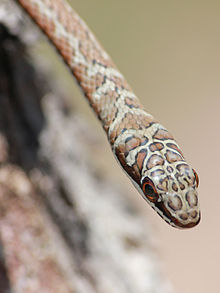| This article needs additional citations for verification. Please help improve this article by adding citations to reliable sources. Unsourced material may be challenged and removed. Find sources: "Psammophis subtaeniatus" – news · newspapers · books · scholar · JSTOR (December 2021) (Learn how and when to remove this message) |
| Psammophis subtaeniatus | |
|---|---|

| |
| Conservation status | |
 Least Concern (IUCN 3.1) | |
| Scientific classification | |
| Domain: | Eukaryota |
| Kingdom: | Animalia |
| Phylum: | Chordata |
| Class: | Reptilia |
| Order: | Squamata |
| Suborder: | Serpentes |
| Family: | Psammophiidae |
| Genus: | Psammophis |
| Species: | P. subtaeniatus |
| Binomial name | |
| Psammophis subtaeniatus Peters, 1882 | |
| Synonyms | |
| |
Psammophis subtaeniatus, the western yellow-bellied sand snake, is a snake found in northern Southern Africa; more specifically the north of KwaZulu-Natal and further north to Mozambique, Zimbabwe, Gauteng, North West, Limpopo, and Eswatini. It is also found in eastern and northern Botswana, northern Namibia, Angola, and Zambia.
It is also known as the striped sand snake and in Afrikaans as the westelike streeppenssandslang.
The snake is oviparous and lays 4 to 10 eggs in summer. The young are about 20 cm long when they hatch. The snake's venom is not considered harmful and poses no danger to humans.
References
- Alexander, G.J.; Tolley, K.A.; Maritz, B. (2021). "Psammophis subtaeniatus". IUCN Red List of Threatened Species. 2021: e.T177449A120632734. doi:10.2305/IUCN.UK.2021-2.RLTS.T177449A120632734.en. Retrieved 26 December 2021.
| Taxon identifiers | |
|---|---|
| Psammophis subtaeniatus | |